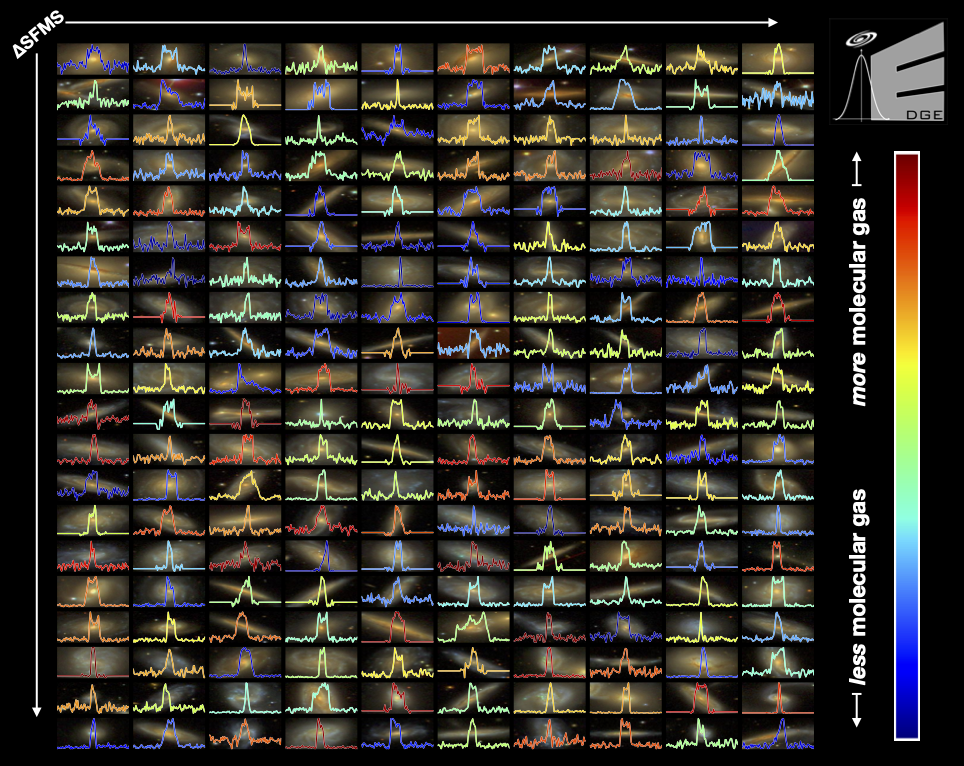The process that brings galaxies to reduce and definitely halt to form stars (the star formation quenching) is the result of a complex interplay of phenomena that are difficult to disentangle without an adequate and statistically significant sample of galaxies. Given this, we have assembled the integrated Extragalactic Database for Galaxy Evolution (iEDGE), collecting stellar continuum, nebular emission lines, and molecular gas information for hundreds of galaxies in the local Universe. iEDGE is, to date, the most comprehensive and extensive database of (CO-based) integrated galaxy properties.
The first iEDGE paper (Colombo et al. 2025a, arXiv:2507.06375) introduces the homogenised database of 643 nearby CALIFA galaxies combining optical integral field unit (IFU) and CO measurements, revealing a strong bimodality between passive early-types and star-forming spirals, with centrally suppressed star formation efficiency (SFE) in passive systems nearly two orders of magnitude below typical global values.
Building on this, the second study (Colombo et al. 2025b, arXiv:2507.06406) examines how star formation scaling relations evolve along galaxies at different quenching stages, showing that molecular gas mass and gas fractions decline steadily from star-forming to retired galaxies, while SFE remains roughly constant during the transition before dropping sharply—particularly in galaxy centres—consistent with inside-out quenching.
Finally, the third paper (Bazzi et al. 2025, arXiv:2507.06709) explores the role of AGN activity in this process, finding that AGN hosts exhibit higher molecular gas masses at fixed quenching stage but follow similar SFE and gas fraction trends as non-active galaxies, suggesting no prominent instantaneous effects of AGN feedback on global star formation properties.
iEDGE will help to contextualise dedicated resolved studies of ageing galaxies, aiming to image the objects in which stars are actually born, the Giant Molecular Clouds, and understand whether their properties and dynamical states can explain why galaxies reduce their star formation efficiency in particular regions. Additionally, the database will be used to assess whether the quenching can be explained by a break in the transition from atomic to molecular to dense gas, by including information from the 21 cm line and dense gas tracers such as high-J CO and HCN transition lines.
Authors: Dario Colombo, Zein Bazzi, Frank Bigiel (AIfA, University of Bonn)
Figure: A collection of 200 CO spectra (roughly a third of the full amount included in the database) overplotted on the SDSS images of the galaxies. The panels are ordered by the logarithmic distance from the star formation main sequence (ΔSFMS), and they are colour-encoded considering the amount of molecular gas inferred from the CO detections. The randomness of the colour distribution suggests that an advanced stage of quenching is not necessarily implied by the absence of molecular gas. The iEDGE is available for download on Zenodo: https://zenodo.org/records/15822433. Image credits: D. Colombo, V. Kalinova, Z. Bazzi & the EDGE-CALIFA collaboration.

